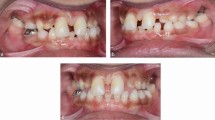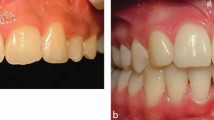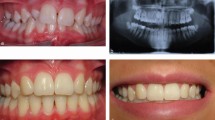Abstract
Hypodontia is a relatively common clinical condition and the second premolar tooth is the most common tooth that fails to develop (excluding third molars). For some patients, no treatment is required, as there is little, if any, consequence of the condition. For other patients, the missing teeth are part of a more complex dental presentation, requiring specialist dental management. This paper describes the clinical decision-making process and explores the options for managing this presentation of hypodontia.
Key points
-
To consider the main clinical decision-making principles for managing hypodontia patients with missing premolar teeth.
-
To understand each of the treatment options for replacing missing premolar teeth.
-
To recognise the important clinical factors required to ensure better outcomes when replacing missing premolar teeth.
This is a preview of subscription content, access via your institution
Access options
Subscribe to this journal
Receive 24 print issues and online access
$259.00 per year
only $10.79 per issue
Buy this article
- Purchase on Springer Link
- Instant access to full article PDF
Prices may be subject to local taxes which are calculated during checkout









Similar content being viewed by others
References
Polder B J, Van't Hof M A, Van der Linden F P, Kuijpers-Jagtman A M. A meta-analysis of the prevalence of dental agenesis of permanent teeth. Community Dent Oral Epidemiol 2004; 32: 217-226.
Tjan A H, Miller G D, The J G. Some esthetic factors in a smile. J Prosthet Dent 1984; 51: 24-28.
Carter N E, Gillgrass T G, Hobson R S et al. The interdisciplinary management of hypodontia: orthodontics. Br Dent J 2003; 194: 361-366.
Patel K B, Woolley J, Kelleher M. Clinical Tips to Improve the Restorative Management of Hypodontia: Part 2. Dent Update 2022; 49: 290-294.
Beaumont J, McManus G, Darcey J. Differentiating success from survival in modern implantology - key considerations for case selection, predicting complications and obtaining consent. Br Dent J 2016; 220: 31-38.
Chesterman J, Chauhan R, Patel M, Chan M F. The management of traumatic tooth loss with dental implants: Part 1. Br Dent J 2014; 217: 627-633.
Beddis H P Durey K A, Chan M F. Survey of consultants in restorative dentistry in the UK regarding ongoing care of patients provided with dental implants. Br Dent J 2017; 223: 255-260.
Misch C E. Maxillary Arch Implant Considerations: Treatment Plans for Partial and Complete Edentulous Fixed and Overdenture Prostheses. In Misch C E (ed) Dental Implant Prosthetics. pp 615-649. Missouri: Mosby, 2015.
Buser D, Martin W, Belser U C. Optimizing esthetics for implant restorations in the anterior maxilla: anatomic and surgical considerations. Int J Oral Maxillofac Implants 2004; 19: 43-61.
Mankani N, Chowdhary R, Patil B A, Nagaraj E, Madalli P. Osseointegrated dental implants in growing children: a literature review. J Oral Implantol 2014; 40: 627-631.
Tufekcioglu S, Delilbasi C, Gurler G, Dilaver E, Ozer N. Is 2 mm a safe distance from the inferior alveolar canal to avoid neurosensory complications in implant surgery? Niger J Clin Pract 2017; 20: 274-277.
Kim J, Jang H. A review of complications of maxillary sinus augmentation and available treatment methods. J Korean Assoc Oral Maxillofac Surg 2019; 45: 220-224.
Taffarel I P, Antelo O M, Guimarães L K, Giacobbo L C, Tanaka O M. Horizontal tooth movement through atrophic edentulous alveolar ridge for bone formation. Eur J Gen Dent 2017; 6: 106-109.
Author information
Authors and Affiliations
Contributions
Courtney Orloff, Shivani Rana, G. Steven Bassi, Martin Ashley and Deborah I. Bomfim all contributed to the concept, preparation of the manuscript and selection of cases for this paper.
Corresponding author
Ethics declarations
The authors declare no conflicts of interest.
Guest Editor, Martin Ashley, was not involved in the peer review process of this manuscript.
Rights and permissions
About this article
Cite this article
Orloff, C., Rana, S., Bassi, G. et al. Restorative dentistry clinical decision-making for hypodontia: managing missing premolar teeth. Br Dent J 235, 483–488 (2023). https://doi.org/10.1038/s41415-023-6333-4
Received:
Revised:
Accepted:
Published:
Issue Date:
DOI: https://doi.org/10.1038/s41415-023-6333-4



